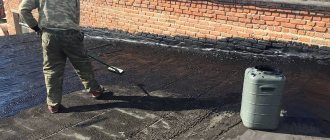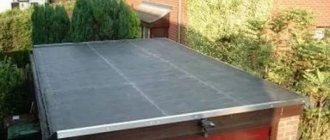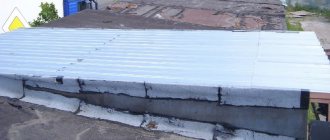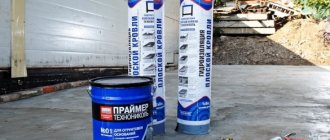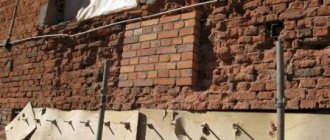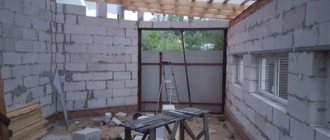In garages, things that do not tolerate moisture are most often stored. Therefore, we will consider what to fill the garage roof with so that it does not leak, we will understand what are the reasons for the formation of cracks, holes and other problem areas, as well as what methods exist for sealing leaking areas. We will also figure out what work needs to be done to eliminate the leak, and what materials are recommended to be used when filling.
Filling the roof with waterproofing Source tildacdn.com
Causes of roof leaks and their consequences
The main causes of roof leaks are poor-quality waterproofing material or improper installation, which can leave gaps.
If you use a cheap coating, it will last a short time and begin to deteriorate. Due to weather conditions, such material becomes covered with cracks that will let water through. Most often this happens due to temperature changes.
Another reason for poor insulation may be the low qualifications of the person who did it. With insufficient skill, even high-quality materials can develop mechanical damage (holes, cuts, cracks).
Also, damage to the protective layer can occur from external factors, for example, tree branches that bend in a strong wind and make a hole, or simply careless work on the garage roof, in which damage occurs from a sharp object.
Example of damaged waterproofing Source mcfallroofing.com
One of the important factors when laying waterproofing is the treatment of materials with anti-fungal agents. If this is not done, then in damp conditions the mold will begin to soften the protective layer of the roof, which is why it will also allow moisture to pass through.
Each material used to protect the roof from water has its own expiration date, which should be taken into account when a leak occurs. Old materials after 10 years of service often become covered with cracks and bubbles, and if this happens, the waterproofing should be replaced.
An example of a very old roof insulation coating Source news.vitebsk.cc
Recommendations for cooking bitumen
For cooking bitumen, it is recommended to prepare a container with thickened walls, since there is a possibility of burning . The optimal heating temperature varies between 160-200 degrees. The higher the temperature, the less time it will take to heat up. On average, cooking the material takes about 3 hours. When cooking, you should not raise the temperature above the recommended values so that the finished coating does not crack due to a damaged structure.
During cooking, you need to monitor the condition and wait for the formation of a homogeneous mass with a glossy surface. The appearance of bubbles and a large amount of smoke indicates overheating of the material. Having finished heating, you need to add crankcase oil and filler to the container, and then immediately begin treating the roof.
Types of repair work to eliminate leaks
Before replacing the coating, you should assess how damaged it is, since a complete repair will be more expensive and time-consuming than coating the seams on the garage roof with liquid resin.
Spot repairs are a way to save time and money when dealing with small gaps in waterproofing. Most often it is used if the area of problem areas is no more than 10% of the total roof size. To seal cracks and holes during spot treatment, patches made of roofing felt or bitumen (sometimes mastic) are used. The patch pieces are attached using heated resin, which in some cases is better than flooding the garage roof with liquid insulation against leaks.
Example of installing a patch Source roofs.club
If the material is damaged up to 20%, it is recommended to partially replace sections with new insulation. To do this, problematic pieces of coating are removed, and a new one is laid in their place. You can also try filling the cracks with resin.
If the damage to the waterproofing is more than 30-35%, then most often it is necessary to completely replace the insulating material. This type of work should be carried out once every 10 years, since with prolonged use of the coating it loses its properties. This method of eliminating leaks is the most time-consuming and expensive, so if it is not necessary, you can limit yourself to spot or partial repairs.
Example of partial repair of leaks Source kakpostroit.su
See also: Catalog of companies that specialize in roofing materials.
Holes or bulges
If the roof is broken through or a bulge has formed on the surface, proceed as follows:
- Using an ax, cut the damaged area crosswise. Use a roofing knife to pry the edges of the roofing felt and unscrew them.
- Clean and dry the roof base under the defective area with a gas torch or a hair dryer. For better adhesion of surfaces to each other, the roof can be lubricated with a primer.
- Lubricate the inside sides of the bent roofing felt and the base of the roof with melted bitumen or mastic.
- Fold the edges back into place , smooth them thoroughly with a roller and press firmly.
- Apply mastic or bitumen to the cut area and place a pre-cut piece of roofing felt on it and press it firmly with your feet.
- For better sealing, lubricate a piece of roofing felt around the perimeter with mastic .
- If the roofing material does not lie tightly and is slightly swollen, press it with a heavy weight for better gluing . After the mastic has hardened, the weight can be removed.
- For more reliable fastening, the roofing felt patch can be additionally nailed with 20 mm nails , the heads of which must also be covered with mastic.
Materials for repairing leaks
The most common material chosen to fill a garage roof against leaks is bitumen. This type of resin is well suited for partial and spot repairs, as well as sealing joints when laying waterproofing.
Bitumen can be liquid or solid. The first type is the most popular for roofing, as it is ready to use without additional steps. The solid analogue is also used for pouring, but before the roof is poured, such bitumen is melted in containers.
A material with similar properties is mastic. It is also good for filling cracks and joints. But you should carefully read the composition of the substance, since not all of its varieties are suitable for roof insulation.
Most often, bitumen mastic is used for this, which contains a binder, oil, as well as rubber and polymer granules. Mastic has increased adhesive properties (sticks well to the surface), but weak protection from ultraviolet radiation.
Bitumen mastic for roofing Source prom.st
If the question arises of how to cover a flat garage roof from leaking, then the main material for such work is roofing felt. It is made from roofing cardboard impregnated with fusible bitumen and coated on both sides with a layer of refractory resin and anti-stick coating (sand, asbestos, talc).
This material is suitable for self-waterproofing a flat roof, but in the case of sloping surfaces it should be used in combination with solid roofing materials such as tiles or slate. Ruberoid is well suited for spot repairs of damaged areas of the roof, as it can be cut into small flexible pieces that are used as patches.
If tiles or slate are used on the roof, and the area of damage is small, then you can try to repair it with roofing felt. This will disrupt the external aesthetics of the building, but may be suitable as a temporary measure before replacing the damaged area.
Rolled roofing felt Source lalafo.com
Local garage roof repair
Local damage to the roofing carpet of flat garage roofs includes
:
- individual cracks;
- swelling of the coating;
- ruptures on the surface of the coating;
- peeling at seams, etc.
Damaged areas must be thoroughly cleaned of dirt and dried
. For this purpose, the places of ruptures are opened with a cross-shaped incision (“envelope”), the cracks expand. Small damaged areas can also be cut out with an ax, making a rectangular “window” to a depth of 3-4 layers of roofing carpet.
For local repairs of roofing material made of roofing felt or built-up materials, bitumen is used, which requires heating, or ready-made cold mastic, as well as a material similar to the top layer of the coating.
Cold bitumen mastic for local repairs is most suitable for sealing deep cracks and minor damage. It can also be used to apply patches. Heated bitumen resin is used to fill any damaged areas, including cracks and cut-out “windows”, and it is important to ensure that the resin penetrates into the furthest and most inaccessible areas.
To repair the damaged area opened by the “envelope”, it is necessary to use patches. The first of them is cut to the size of the “envelope” and placed inside on a base well coated with bitumen. The bent edges of the coating must also be thoroughly coated with bitumen and pressed tightly to the surface. The external patch should extend beyond the edges of the repaired area by 150-200 mm. It is laid on a layer of bitumen mastic or heated resin and smoothed tightly.
Blisters in the outer covering need to be cut, air released, coated with mastic and pressed tightly. Seams that have lost their tightness are cleaned of old mastic, dried, and re-glued using bitumen material.
If the surface of the repaired area is covered with bitumen, it is recommended to pour a layer of sand on top to protect the bituminous material from ultraviolet radiation. UV radiation makes bitumen brittle, which shortens the lifespan of the repaired roof.
How to properly seal a roof
Let's consider what to do if the roof pokes in a garage with a flat or sloping surface. First, you need to conduct an external inspection for damage in places that are located above the puddle or next to them, since the leak may be nearby.
You should also inspect the quality of the material, check its expiration date (if possible) and compare it with the last replacement of the coating. This is necessary in order to understand whether it is necessary to change the waterproofing completely or whether you can limit yourself to spot repairs.
After problem areas have been found, you should clean the surface of debris and sweep away dust using a broom, broom or construction vacuum cleaner. After this, you need to begin repairs, but the procedure for each type is different.
For spot repairs, before you pour the garage roof, you need to clean out cracks or holes using an angle grinder with a sanding wheel or another sanding tool, such as sandpaper. This is necessary to remove the layer of powder so that the bitumen can better fill the cracks.
Joint divergence
- If the joints diverge, lift the pieces of roofing material and dry them very thoroughly using a gas torch or a hair dryer.
- Coat the joints with a layer of heated mastic or bitumen, put the roofing material in place, and stamp it down.
- Coat the top of the joint with bitumen or mastic.
At the end of the work, it is advisable to sprinkle the repaired area with sand, as this will prevent the area from overheating in the sun and protect the mastic from melting.
Regular roof repair is a troublesome task, but a roof repaired on time will last much longer, and the repair itself will be cheaper than replacing the entire roof.
Video description
This video shows a way to eliminate cracks in a garage roof using patches.
After this, the roofing material needs to be pressed firmly against the problem area, but do this carefully so as not to damage the covering on the roof and the patch itself. After the edges have dried, you can improve the waterproofing of the patch by covering its surface and joints with bitumen mastic.
The process of complete or partial replacement of roofing felt sheets is similar to sealing with a patch, only before carrying out repairs it is necessary not only to clean the damaged areas, but to remove several top layers of coating.
The cleaned and prepared area also needs to be filled with bitumen or special mastic to create a sticky film. After the liquid has dried a little, roofing material is laid on its surface. A small overlap of 10-15 cm should be made so that water does not leak at the joint. Subsequent layers are laid so that the middle of the top sheet overlaps the seam between the lower layers.
An example of laying new layers of roofing felt Source stroy-texnika.com.ua
We patch the canvas using patches
There is another method of closing leaks that will help you figure out how to close the garage roof to prevent leaks - installing roofing felt patches. They are perfect for eliminating minor damage that has appeared in different places on the canvas. To make patches you will need roofing felt with flake or coarse dusting, bitumen mastic, a knife, varnish and a piece of emery.
For this method of eliminating defects, you will need to perform the following steps:
- Clean the roof. The base of the slopes must be thoroughly cleaned of dust and other contaminants.
- Preparation. The protective coating is removed from the restored surface, and to ensure better adhesion between the layers, they are degreased and dried.
- We make patches. We take roofing material and cut patches - their size should be one and a half to two times the area of the defective area. In order for the patches to acquire an even shape, they are placed on a flat surface for 1-3 hours.
- Next, bitumen is poured onto the treated area to obtain a film that will improve the adhesion of the patch.
- The inner base of the roofing felt patches is heated with a gas burner, and then pressed firmly against the problem area of the roof.
- Next, the upper part of the patch is opened with one or two layers of kukersol varnish or bitumen mastic to increase the waterproofing qualities of the restored area.
It is worth noting that to create patches, it is advisable to take roofing material with a density of at least 400 g/m2 with stone powder. To simplify the work, you can take material with a self-adhesive base, and they should only be performed at ambient temperatures above 5 ℃.
Briefly about the main thing
The main causes of leakage are poor quality materials and unskilled workers. In both cases, it should be remembered that if you save too much, the roof may begin to leak immediately after installation, and this will lead to additional expenses.
The most common materials for sealing cracks in garage roofs are bitumen and roofing felt. They have good adhesive and water-repellent properties.
You should carefully consider what type of work is needed to fix the leak, since completely replacing the entire coating will cost a lot of money. This can be avoided by spot repairs if there are few problem areas: they can be repaired with patches or simply filled with resin.
Tip #6. If the problem is at the base
Often holes appear in concrete ceiling slabs or other floors. In this case, you first need to seal them in any suitable way and be sure to waterproof them.
Suitable patches are made only from hard, durable materials. Because when using soft coatings, there is a possibility of sagging over time and, as a result, a new leak.
One solution to the problem is presented in the video:
Advantages of petroleum based mastic
The most common bitumen mastic has a number of valuable advantages:
- Light weight.
- Resistant to almost any aggressive environment.
- Possibility of tinting.
- Easy to apply and can be easily applied by anyone.
- Elasticity.
- Sufficient viscosity, which makes this mastic universal.
- Affordable and economical.
- Resistant to insolation.
- Excellent waterproofing properties, making roof repairs reliable and durable.
- Durability.
- Seamless. The presence of seams and joints is the biggest problem of any roof.
- Particular tensile strength, especially for bitumen mastics with rubber in the composition.
- Stability and uniformity of application.
- The ability to repair roofs of any shape and design, even the most complex.
- Fire resistance. Bitumen mastic can withstand fairly high temperatures.
And the most valuable property of bitumen mastic as a repair material is that it stretches and contracts without any consequences. After all, every second crack on the roof is subject to expansion (due to the reasons for which it arose), and conventional repair compounds without the necessary elasticity simply break. At the same time, bitumen mastic completely takes on the deformation load and copes with it perfectly.
But to ensure that all these qualities are not lost, buy only good quality mastic from a trusted manufacturer. Otherwise, the result is quite difficult to predict, and any new leaks, while you patch them up again, will have time to cause a lot of problems. Therefore, the main thing is that the bitumen mastic that you plan to use for roof repairs is produced in accordance with all GOST standards. And this means:
- Uniformity of composition.
- Easy to apply to the area being repaired.
- Heat resistance not lower than 70°.
- No emissions harmful to human health.
- Excellent adhesive ability.
- Waterproof and bioresistant.
Thus, the most famous domestic manufacturers of bitumen mastics are “Grida”, “TechnoNIKOL” and “RusMonolit”. Butyl rubber “Polikrov M-140”, bitumen-latex “Blem-20”, chlorosulfopolyethylene “Polikrov-L” and such as Elamast, Venta-U, Gekopren and Blem-20.
